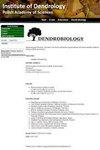Revisiting the taxonomy of Populus lasiocarpa × P. wilsonii hybrids
IF 1.8
4区 农林科学
Q2 FORESTRY
引用次数: 0
Abstract
Although hybrids between Populus lasiocarpa and P. wilsonii have been known for many years, they have not been given a valid nothospecies name. Resolving the classification issue of these bigleaf poplars is now even more necessary because they are known not only from cultivation, but recent evidence confirms their spontaneous occurrence in Hubei Province, China (Zhang, unpublished information). The two species were first artificially crossed in 1956 in Poland and again independently in 1974 in Sweden. Initially, this taxon was described as P. ×wilsocarpa (Bartkowiak & Bugała, 1978). However, this name was invalid due to the lack of Latin diagnosis (which was required at that time) and lack of type designation. In 1996, Böcker and Koltzenburg proposed the name P. ×kornicensis for this hybrid, but it too was invalid for similar reasons and lack of description. In our work, we revisited these poplars and validated the name proposed by Böcker and Koltzenburg by providing a description and type designation. Considering the overall appearance of these hybrid poplars (silhouette, branching pattern), they bear a closer resemblance to P. wilsonii. Other analyzed morphological features are mostly intermediate compared to the parent species, but overall, they lean slightly more towards P. lasiocarpa. We highlight the main diagnostic characteristics that distinguish these species.杨杨杂种分类的再探讨
尽管人们多年前就已经知道了lasiocarpa和p.w elsonii之间的杂交品种,但它们还没有一个有效的非物种名称。解决这些大叶杨树的分类问题现在更加有必要,因为它们不仅从栽培中被了解,而且最近的证据证实它们在中国湖北省自然发生(Zhang,未发表的信息)。1956年在波兰首次人工杂交,1974年在瑞典再次独立杂交。最初,这个分类群被描述为P. ×wilsocarpa (Bartkowiak &Bugał,1978)。然而,这个名字是无效的,因为缺乏拉丁诊断(这在当时是必需的)和缺乏类型指定。1996年,Böcker和Koltzenburg提出将这种杂交种命名为P. ×kornicensis,但由于类似的原因和缺乏描述,它也无效。在我们的工作中,我们重新审视了这些杨树,并通过提供描述和类型名称来验证Böcker和Koltzenburg提出的名称。考虑到这些杂交杨树的整体外观(剪影,分枝模式),它们与威尔逊杨更相似。与亲本种相比,其他分析的形态特征大多处于中间状态,但总体而言,它们更倾向于P. lasiocarpa。我们强调区分这些物种的主要诊断特征。
本文章由计算机程序翻译,如有差异,请以英文原文为准。
求助全文
约1分钟内获得全文
求助全文
来源期刊

Dendrobiology
农林科学-林学
CiteScore
2.20
自引率
11.10%
发文量
17
审稿时长
>12 weeks
期刊介绍:
Dendrobiology publishes original research articles and review articles related to the biology of trees and shrubs.
 求助内容:
求助内容: 应助结果提醒方式:
应助结果提醒方式:


